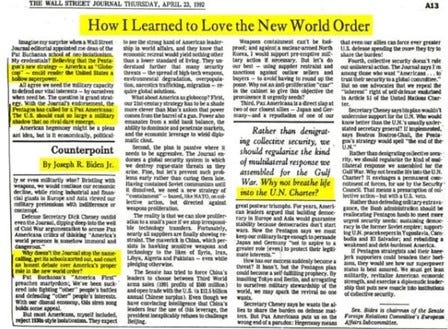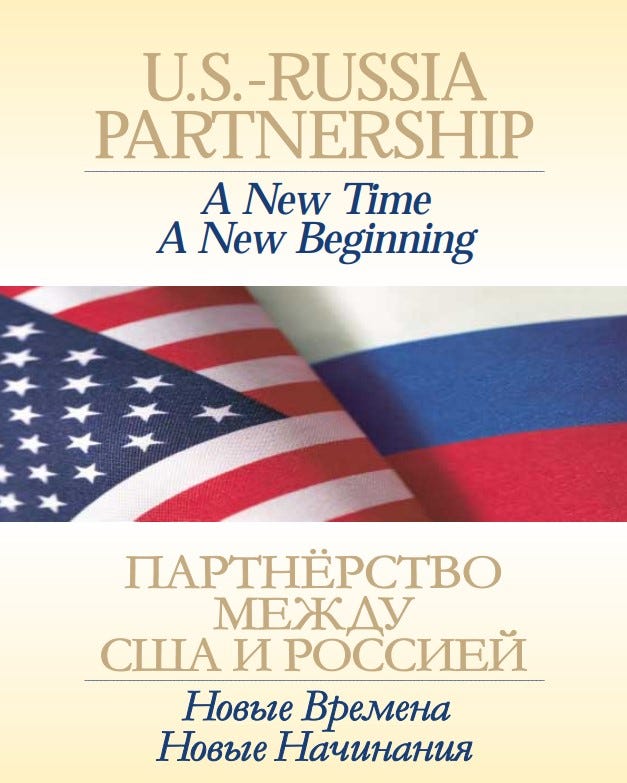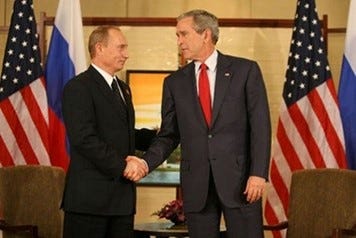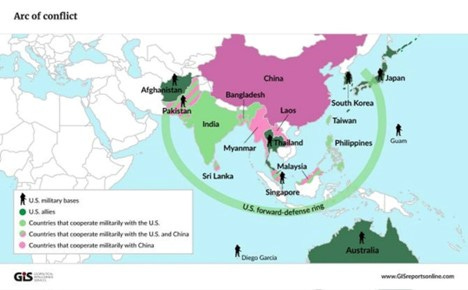“The future ain’t what it used to be.” — Yogi Berra
As nations look toward the future with mixture of hope and trepidation, it is worth asking: how did this dangerous theater of the absurd arise? Has the USA always exhibited such delusions, and if it was once truly a beacon of hope and temple of liberty, can it yet be brought back to its saner traditions in order to avert disaster?
Talk of nuclear Armageddon has become commonplace, and it appears that no effort to heal the divide between east and west is considered by any of the neo-liberal politicians occupying positions of authority.
What is going on? Has the world gone insane?
Why have leading figures of the “free and democratic” west become so blind to even their own strategic interests to the point that they would voluntarily risk spreading thermonuclear fire across the globe rather than end the policy of “global NATO” and international unipolarism?
This man-made crisis, like all man made crises, has solutions.
But these solutions require that both sides Russian and American alike properly identify the nature of those agencies pushing the world to the brink of extermination.
For it is only by doing this, that we may properly appreciate the potential of restoring the USA itself back to its constitutional traditions while at the same time establishing a basis of a genuine new security architecture so desperately needed if the world will survive the remaining decades of the 21st century.
Understanding the pathway needed to navigating through the current storm requires revisiting a bit of recent history, starting with the collapse of the soviet union and the three pregnant moments which nearly saw humanity embrace a new epoch of win-win cooperation driven by a US-Russian strategic alliance.
How America Lost her Moral High Ground
It wasn’t long ago that there were many positive reasons to find pride in America as the City on a Hill which our founders envisioned.
John F Kennedy’s New Frontiers provided a vital long-term perspective to young people who wanted to make the world a better place, end poverty and explore new cultures without bombing anyone. The insanity of the Vietnam war sadly de-railed much of that positive momentum, but still the better part of the United States continued onward throughout the remaining decades of the Cold War.
Contrasted with the stifling authoritarian environment of the Soviet Union of the 1960s-1980s, the USA still appeared in many ways to be a mecca of freedom, where personal initiative was cherished, transformative large-scale infrastructure projects were built and new discoveries emanating from the frontiers of the space program were finding quick application in the civilian economy.
Under the heavy hand of the rigid Politburo, freedom of travel for normal citizens was as restricted as freedom of expression, freedom of speech and freedom of assembly. Sure, there were injustices, political turmoil and dissent in the USA… but at least this dissent was protected by the Constitution.
In the Soviet Union, not only were such freedoms absent, but even the basic expectation that scientific progress could beneficially improve the working class was disregarded. Unlike the USA, the pioneering scientific advances driven by the Soviet military were rarely ever able to find any application to the civilian sector, as outdated agro-industrial practices only re-enforced a stifling sense of stagnation within the hearts and minds of the Russian youth.
The west was far from perfect, but at least things were improving, and throughout the Cold War, it was generally believed that the world would be better for new generations.
By the time the Cold War ended, there was great cause for celebrations, as the fear of nuclear terror was finally fading away. A new age of infrastructure and cooperation between east and west was going to be unleashed, with Deutsch bank president Alfred Herrhausen promoting a strategic vision for a productive zone of advanced development across Europe and Russia. Leading American statesmen affiliated with the Reagan administration joined Herrhausen, calling for billions of dollars in development aid to assist the Soviet Union in embracing industrial capitalism and democracy.
Schiller’s beautiful poem Ode to Joy, set to music by Beethoven was performed in China during the early days of Tiananmen Square, in Germany during the fall of the wall, and soon even became the basis of the European Union’s anthem. For young and old alike, a new age of brotherhood was anticipated for all humanity.
1988-1992: The First Attempt at an Age of Multipolar Cooperation Is Subverted
By 1988, it was becoming increasingly clear that the system of mutually assured destruction was coming to an end.
The rigid economic systems of the Soviet bloc had been incapable of introducing the needed technological innovations to the general civilian economy, which would have been needed to avoid a general breakdown.
Everyone knows of the dark days of Perestroika and the western-directed looting of the 1990s… but few are aware of the ripe potential for a new age of cooperation and abundance driven by forces within the American intelligentsia and their Russian counterparts, who saw in this crisis, an opportunity to turn swords into plowshares.
These figures sought to build a new architecture based on mutual development, trust-building measures and scientific progress.
Back channel discussions had been arranged for several years, with leading figures of the new Gorbachev administration and their American counterparts within the Reagan administration, and even the industrial leaders of Germany led by Deutsche Bank Chairman Alfred Herrhausen.
These anti-Malthusian statesmen may not have fully appreciated the evil forces they were challenging, but they nonetheless worked hard to end the Cold War not by crushing Russia into oblivion, but in providing a new synergy of industrial and scientific cooperation between east and west.
The story of these plans and possibility for an age of cooperation premised on large-scale industrial progress is told both in the recent autobiography of American University in Moscow’s Dr. Edward Lozansky, as well as in the 2008 Schiller Institute documentary The Lost Chance of 1989.
These figures worked hard to present development plans which involved billions of dollars of promised investments into the modernization of all sectors of the Soviet economy premised around large scale infrastructure and industrial growth.
Despite the many promises of east-west cooperation, the 1990s instead saw a bloodied Russia swimming with sharks.
Figures like Strobe Talbott, and Jeffrey Sachs were assigned the task of breaking the Russian government and its people economically, psychologically and morally under a program of Shock Therapy overseen by the worst elements of the IMF, City of London and Washington utopians.
Even basic security guarantees were abandoned, as the promises made by then Secretary of State James Baker to “not move NATO one inch beyond its 1992 configuration” were increasingly abandoned, as NATO transformed from a Cold War defensive alliance to an aspiring new global offensive structure, absorbing as many former Soviet Nations it could acquire.
Instead of cooperation, speeches calling for a New World Order and “end of history” became part of the western political discourse.
Even then-Senator Joe Biden was quick to get into the action, writing such 1992 tracts as, “How I learned love the New World Order”
For those nations resistant to this New World Order, Balkanization and bombs were swiftly deployed to shake them into “correct behavior”.
Behind the illusion of America’s victory over communism, a rot could be felt growing ever faster, as the post-industrial policies of the 1970s and 1980s were transforming America’s once powerful industrial base into a useless services economy with no sovereign capacity to stand on its own feet, produce for itself or even maintain basic infrastructure.
Poverty, drug use and crime increased under Clinton, while a wealth transfer was taking hold that saw America’s dwindling small and medium sized entrepreneurs wiped out under new behemoth corporations, who enjoyed free reign to gobble up everything they could acquire under the financial deregulation bonanza of the North American Free Trade Agreement and Europe’s Maastricht Treaty. In both treaties, former zones of sovereign nations were stripped of their power to legally emit productive credit, use protectionism to defend their interests, or control their own national banking systems.
Where sovereignty over these vital powers was once legally the prerogative of the nation, after NAFTA and Maastricht, supranational entities now enjoyed this privilege.
Within this decay on all sides of the former Iron Curtin, two new leaders came to power.
With their ascension in 1999 and 2000, it was hoped that Vladimir Putin and George Bush Jr. might be able to restore a measure of sanity after a decade of betrayal.
1999-2001: The Second Attempt at an Age of Multipolar Cooperation Is Subverted
By the year 2000, hopes were again high that the dismal decay of US-Russian relations could be healed, as a young trouble shooter named Vladimir Putin was brought into play in Moscow, replacing the alcoholic trainwreck that was Boris Yeltsin.
The defeat of Al Gore (whose deep relationship with Russian traitors such as Chernomyrdin and Chubais left him with no shortage of Russian blood on his hands) awoke a weary optimism among patriots in both nations.
Within the USA, over 100 elected representatives endorsed a call led by republican congressman Curt Weldon of Pennsylvania, who commissioned a report titled “US-Russia Partnership: A Time for New Beginnings“.
In this influential document published in early 2001, a coherent vision not seen in over a decade was presented that called for a new paradigm, touching on every aspect of US-Russian relations.
Cultural diplomacy, the teaching of Russian in American schools, Agricultural assistance, full spectrum energy development, space exploration, defense cooperation, asteroid defense, and fusion research all figured prominently in Representative Weldon’s dossier.
The sensitivity to the existential moment not being lost to history can be seen in the report’s opening remarks:
“America and Russia must forge an alliance beneficial to both, or face the near certainty that historical suspicions will reassert themselves and plunge the world into a new Cold War. Such an eventuality would be especially tragic, since the United States and Russia have more in common than not. Indeed, given that the gravest and most imminent threats to both nations are terrorism and WMD proliferation, these great common enemies should make the United States and Russia natural allies.
The Cold War era model of bilateral relations and arms control is predicated on mutual antagonism and nuclear threats: a situation that is unacceptable as the basis for 21st Century U.S.- Russian relations.
Russia and the United States each have unique security concerns, but have more security concerns that are shared in common. U.S. policy should encourage Russia to recognize the advantages of U.S.-Russian cooperation in areas like counter-terrorism, non-proliferation and missile defense…
The key to forging a U.S.-Russian alliance is to do it now, before U.S.-Russian relations deteriorate further. The United States must offer Russia a relationship that clearly benefits Russian as well as U.S. interests, and begin as soon as possible, working jointly toward mutually beneficial goals.”
It was this spirit of goodwill within the leading strata of American policy makers that Vladimir Putin spoke towards when he made his intention for Russia’s participation in NATO known to the west.
Of course, Putin was not ignorant to the dangers NATO posed under the influence of unipolarists like Gore, Soros, Nuland et al, but as long as figures who thought differently exercised power among western nations, then Russia’s intelligentsia presumed it to be an organization whose destructive orientation could be neutralized.
It was for this reason that Putin’s early appearances in the USA during this period alongside President Bush demonstrated the optimism that a sane foreign policy might be adopted.
Sadly, another darker current within the US governing class was emerging with the incoming Bush Administration which had a very different view of things.
This group not only carried on the worst elements of the Clinton-Gore-Talbott Russia policy of the 1990s, but added an obsessive militaristic drive for global supremacy with a Pax American flavor not seen in the previous regime.
Figures like Strobe Talbott’s assistant Victoria Nuland went on to find new employment as Dick Cheney’s assistant and soon US Ambassador to NATO, where she oversaw the military bloc’s vast expansion from 16 to 24 nations by 2008.
Under Nuland’s lead, Georgia and Ukraine’s aspirations to join the alliance was welcomed officially by NATO.
Nuland also worked closely with the CIA front group National Endowment for Democracy and George Soros in setting the stage for a new era of regime change operations in the form of color revolutions in Georgia (2003), Ukraine (2004) and the scorched earth humanitarian bombing of nations back to the stone age across the Middle East in the wake of 9/11.
Nuland’s husband Robert Kagan was an early co-founder of the Project for a New American Century- a neoconservative think tank which produced such dystopic policy visions for the 21st century as the September 2000 Rebuilding America’s Defenses, which saw both Russia and China, not as potential allies, but as intrinsic enemies to be destroyed if the planned global hegemony of the USA was to be ensured.
In total opposition to the positive spirit of win-win cooperation envisioned by Representative Curt Weldon and company, the unipolarist networks outlined in the PNAC RAD document envisioned a much more dystopic world order of Hobbesian struggle of each against all, when they envisioned the wars of the future, saying:
“Although it may take several decades for the process of transformation to unfold… “combat” likely will take place in new dimensions: in space, “cyber-space,” and perhaps the world of microbes. Air warfare may no longer be fought by pilots manning tactical fighter aircraft sweeping the skies of opposing fighters, but a regime dominated by long-range, stealthy unmanned craft… Space itself will become a theater of war, as nations gain access to space capabilities and come to rely on them; further, the distinction between military and commercial space systems – combatants and noncombatants – will become blurred.
Information systems will become an important focus of attack, particularly for U.S. enemies seeking to short-circuit sophisticated American forces. And advanced forms of biological warfare that can “target” specific genotypes may transform biological warfare from the realm of terror to a politically useful tool.”
The thinking of grand strategist Zbigniew Brzezinski was visceral in the pulse of ideologues like Kagan, Nuland and other neocons like Paul Wolfowitz, Richard Perle, John Bolton, Donald Rumsfeld and Dick Cheney, who ran the malleable Bush Jr presidency.
It was former National Security Advisor Brzezinski who outlined the needed carving up of Russia in his 1997 Grand Chessboard under Washington diktat, which could also be smelled across the pages of the PNAC white papers.
In his 1997 book, Brzezinski wrote:
“Potentially, the most dangerous scenario would be a grand coalition of China, Russia, and perhaps Iran, an ‘anti-hegemonic’ coalition united not by ideology but by complementary grievances.”
Brzezinski added: “How the United States both manipulates and accommodates the principal geostrategic players on the Eurasian chessboard and how it manages Eurasia’s key geopolitical pivots will be critical to the longevity and stability of America’s global primacy.”
Unfortunately for the world, the policy doctrine which was adopted by George Bush was not that of the better American patriots surrounding Curt Weldon, but rather this hive of unipolarists who sought to do everything possible to ensure that the world would remain as divided and suppressed as possible, while a new Pax Americana could consolidate its possessions under a program of Full Spectrum Dominance.
It was this group that ensured the USA would soon quit the Anti Ballistic Missile Treaty, which Bush announced in December 13, 2001.
The 1972 ABM Treaty had ensured that both Russian and American militaries cease deploying, testing and developing sea, air, space and mobile land based anti-missile systems for intercepting strategic ballistic missiles.
The USA’s withdrawal from this treaty made the increased danger of the ballistic missile shield built up around Russia (and China’s) perimeters an unbearable existential threat, and a new arms race between offensive and defensive systems was launched.
A day after the USA officially left the ABM Treaty, Russia announced its withdrawal from the START II Treaty, which would have not only banned the use of multiple warheads on ICBMS, but also vastly reduce the total number of warheads.
It wasn’t long before President Putin called out this threat during his famous 2007 Munich Security speech which laid out not only Russia’s understanding of the true intentions underlying the offensive properties of the Ballistic Missile systems built up across her borders, but also set firm red lines regarding NATO’s continued encroachment on Russia.
2016-2020: The Third Attempt at an Age of Multipolar Cooperation Is Subverted
Between 2007-2016, the western unipolarists had doubled down on Full Spectrum Dominance despite the fact that the contours of world politics had drastically changed, with the new Russian-Chinese alliance that had become a bedrock of the success of Eurasian integration.
Other nations had been swept into hell under a western-manipulated Arab Spring, followed by the 2011 humanitarian bombing of Libya and the targeting of Syria for similar “nation building” treatment.
In the Pacific, the Clinton-Obama Asia Pivot had accelerated US military commitment across China’s perimeter, with THAAD Missiles in South Korea and 100,000 troops spread across western-manipulated Asian governments.
Under Biden and Victoria Nuland’s lead, Ukraine was lit on fire, as a pro-Russian government of Viktor Yanukovych was overturned in a 2nd color revolution and a regime chosen by the US State Department was installed in power.
Amidst this world of darkness, a light was beginning to shine, as China announced the Belt and Road Initiative as its new foreign policy in October 2013, which soon began merging with Russia’s Eurasian Economic Union.
In 2015, Russia was sufficiently strong to launch into a new foreign policy doctrine in Syria, which prevented another regime change project from lighting the heartland on fire.
By 2016, things were looking bleak for the world, as all public opinion polls in America were forecasting certain victory for Hillary Clinton as the 45th President of the United States.
But something changed.
The upset victory of Donald Trump did more than merely derail the continuation of a neocon agenda, which had found a new home in the worst elements of the Democratic Party of Obama and Clinton, but a new potential for rebuilding US-Russian relations was beginning to be felt as the new president called for good relations with Russia and China while also pushing for ending the “never ending wars” and re-calibrating American military activity in Syria with the Russians.
Throughout the 2016-2020 presidency of Trump, a full assault was launched to undo the vote of the majority of American citizens through gaslighting, “Russiagate” propaganda, and vast media witchhunts, which attempted to paint Trump as “a Kremlin stooge”.
Despite this, Trump was able to fend off impeachment attempts, and managed a variety of reforms that entailed cutting NED funding in Ukraine, Hong Kong and beyond, severing vital components of the CIA from conventional military operations, harmonized US miliary operations with Russia in Syria, and drove a vast program of diplomatic bridge building across the middle east with the Abraham Accords and in Asia, where Trump brokered meetings with South and North Korean leaders.
This bridge building was most important in regards to the leadership of Russia and China.
It was in April 2019, that President Trump appeared at the White House alongside Chinese Vice Premier Liu He and said:
“Between Russia, China and us, we’re all making hundreds of billions of dollars’ worth of weapons, including nuclear, which is ridiculous. I think it’s much better if we all got together and didn’t make these weapons; those three countries I think can come together and stop the spending and spend on things that are more productive toward long-term peace.”
Although Deep State operations active within the US State Department worked tirelessly to sabotage these positive initiatives, and although neo con swamp creatures like John Bolton and Mike Pompeo continued to surround Trump’s inner circle like vipers, it would be foolish to ignore these positive, albeit short lived initiatives to revive the missed chances of 1990 and 2000.
Will “The Other America” Please Stand Up?
After four years of Biden’s dismal presidency, the world has slid once again towards an existential cliff of confrontation, not only with Russia over the events in Ukraine, but increasingly China, with the build up of a new NATO-of the Pacific which some have come to dub the “Quad”.
Where a post-NED color revolution Ukraine was used as a flashpoint for this antagonistic program against Russia, a post-NED color revolution in Taiwan (under the 2014 Sunflower Revolution) was used to turn this Pacific island province of China into a new potential flashpoint of war in the Pacific.
With 140+ countries joining onto the Belt and Road Initiative, and an increasing list of nations waiting to join the BRICS+ and Shanghai Cooperation Alliance, it is becoming increasingly clear that the nightmare of Zbigniew Brzezinski of a Russia-China-Iran led new Eurasian Alliance is threatening to forever upset the unipolar paradigm.
President Putin made such a point clear in a recent speech calling out the end of the unipolar system
The American population know that they do not benefit from the proxy war in Ukraine, and according to recent polls, the situation of Ukraine doesn’t even make the top 10 concerns for most Americans, who care more for increased gas, food and rent prices over the geopolitical ambitions of detached neocons.
The previous three attempts to overthrow the unipolarist ideologues and establish a sustainable foundation of US-Russian cooperation were made possible not only through well positioned politicians, but a network of well organized, informed and engaged American citizens who understood how to think about the direction their nation was headed.
If today’s world is to avoid the consequence of the insane policies of Global NATO, which can lead only towards thermonuclear war, then it will be thanks to the important factor of this “other America” whose time, energy and sacrifice may make all the difference between a new dark age or new age of cooperation.
Click here to watch the documentary ‘The Other America’- adapted from the above essay:
Matthew Ehret is the editor-in-chief of The Canadian Patriot Review, Senior Fellow of the American University in Moscow and Director of the Rising Tide Foundation. He has written the four volume Untold History of Canada series, four volume Clash of the Two Americas series and Science Unshackled: Restoring Causality to a World in Chaos. He is also co-host of The Multipolar Reality on Rogue News and Breaking History on Badlands Media.
Badlands Media articles and features represent the opinions of the contributing authors and do not necessarily represent the views of Badlands Media itself.
If you enjoyed this contribution to Badlands Media, please consider checking out more of Matthew’s work for free on Substack.
Badlands Media will always put out our content for free, but you can support us by becoming a paid subscriber to this newsletter. Help our collective of citizen journalists take back the narrative from the MSM. We are the news now.









Many Americans are breathing a sigh of relief after election day. Trump coming back into office is our only hope for a new day of peace and prosperity. We must all add our confirmation to this reality through prayer and positive affirmation. The majority of Americans are now very aware of the globalist agenda thereby giving Trump's plan a big and beautiful mandate to restore world peace and to make America the shinning city on the hill once more.
Thanks Matt. I enjoyed your article as well as your video.
Trump WON! I believe the Other America is on it's way.
The Best Is Yet To Come!
God Wins!
God Bless!!!